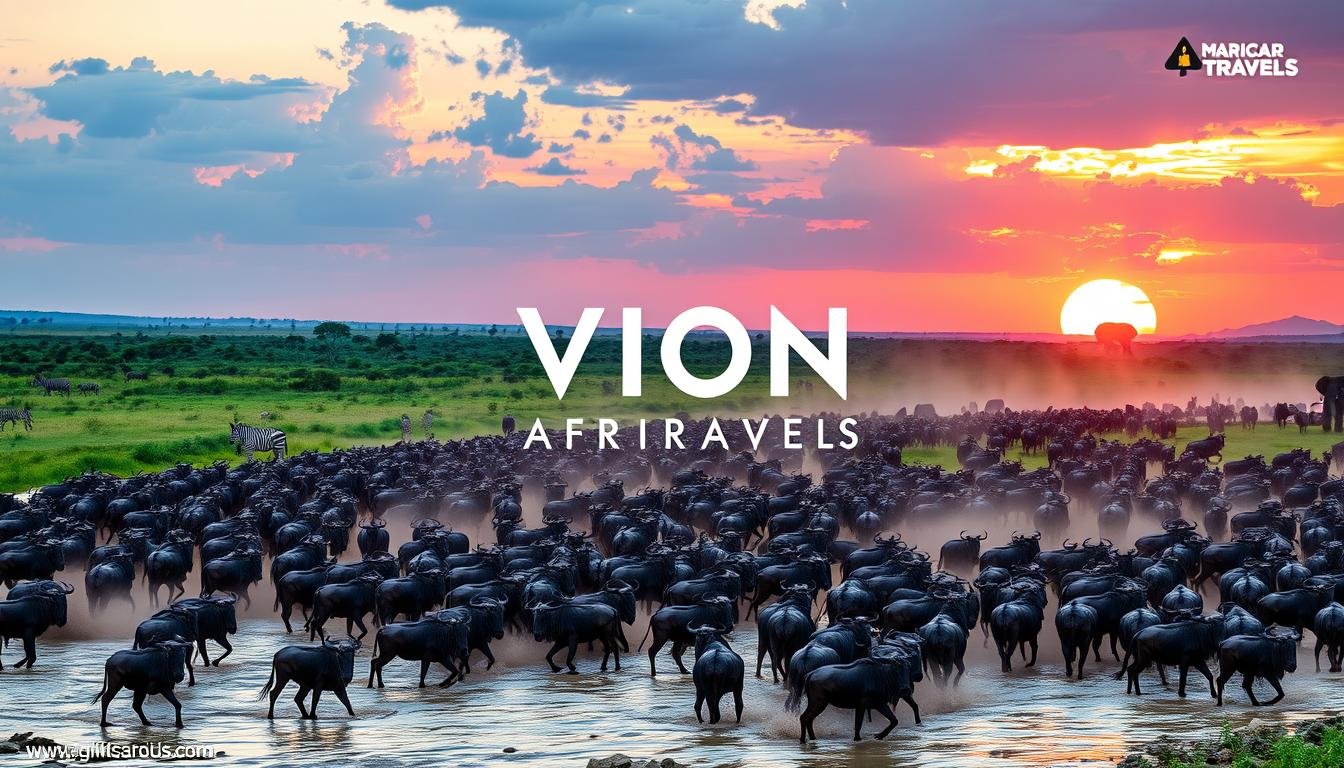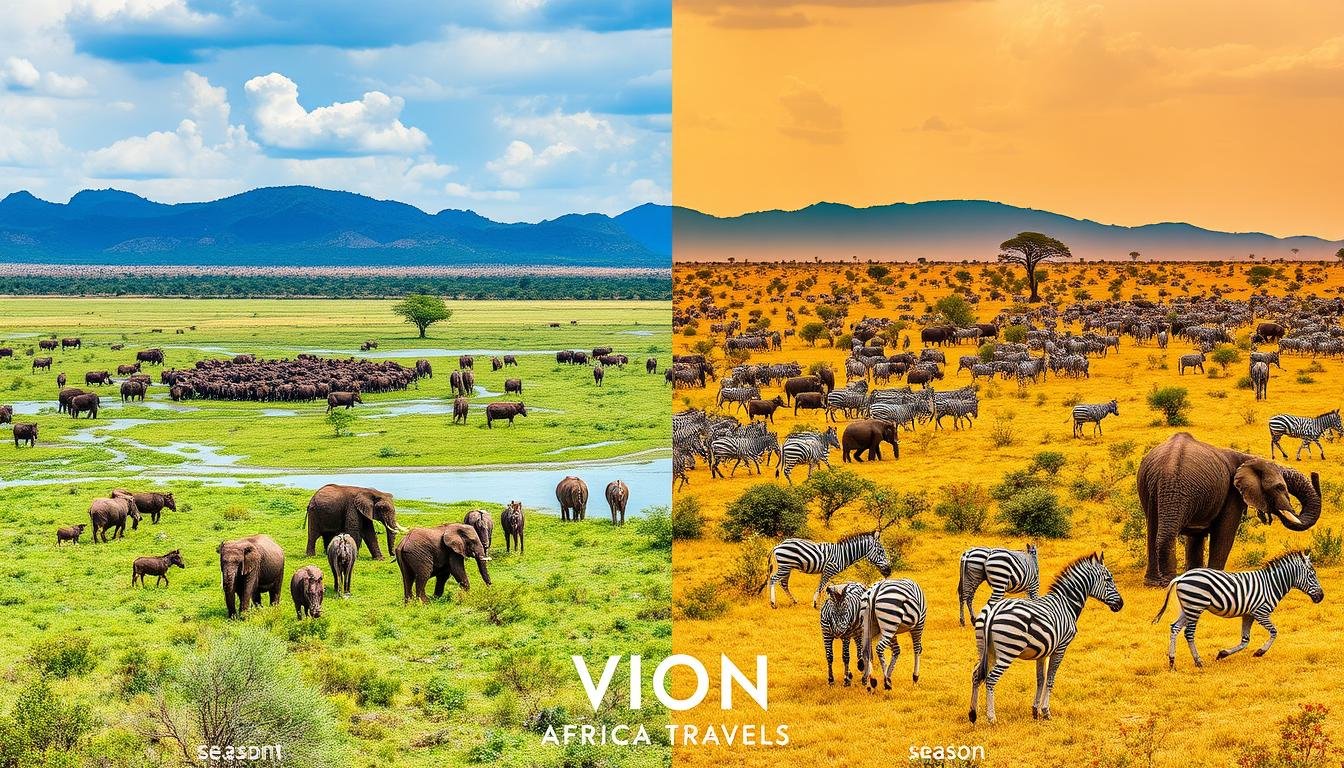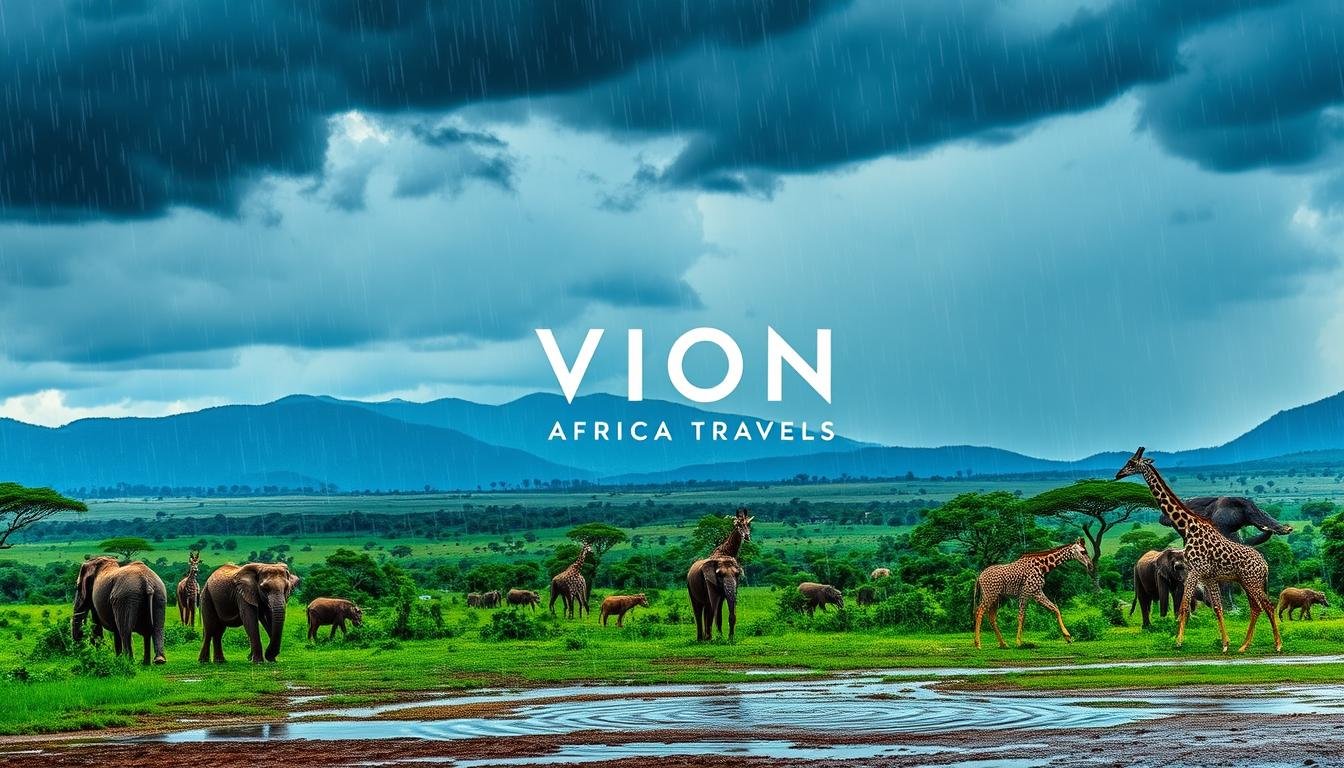Best time to go on a safari in Tanzania: Going on a safari in Tanzania is an exciting and unforgettable journey. But, knowing the best time to go is key to enjoying your African adventure fully. In this guide, we’ll look at the best seasons and things to think about when planning your safari. This way, you’ll see the best wildlife, beautiful landscapes, and get to know the local culture.
Key Takeaways
- Understand the distinct rainy and dry seasons in Tanzania and how they impact wildlife behavior and safari experiences.
- Discover the advantages and drawbacks of visiting during high and low tourist seasons, and how to balance cost, availability, and crowds.
- Learn about the annual Great Migration and the best times and locations to witness this incredible natural phenomenon.
- Explore the seasonal highlights and unique attractions of Tanzania’s diverse national parks, including the Serengeti, Ngorongoro Crater, and Tarangire.
- Optimize your photography and cultural experiences by aligning your safari with the ideal weather, lighting, and local festivals.
Understanding Tanzania’s Climate and Seasons
Many dream of exploring Tanzania’s diverse landscapes. To fully enjoy our safari, knowing the climate is key. Tanzania’s weather changes a lot throughout the year. Knowing these changes helps us plan the best safari, whether in the dry or wet season.
Rainy Season Overview
The rainy season in Tanzania, also called the “green season,” is from November to May. This time, the country sees a lot of rain, especially from March to May. Though rain might change our plans, the green landscapes and fewer crowds offer a peaceful safari.
Dry Season Overview
The dry season in Tanzania is from June to October, with July to September being the driest. This is the best time for a Tanzania dry season safari. The thinning vegetation makes animals easier to see, and rain is less likely to ruin our plans.
The Importance of Climate in Safari Planning
Knowing Tanzania’s climate and seasons is vital for planning our safari. The time we visit greatly affects the wildlife we see and the conditions we face. Choosing the right season ensures we have the best Tanzania wet season safari or Tanzania dry season safari experience.
“The best time to visit Tanzania is when the weather and wildlife align with your personal preferences and travel goals.” – Experienced Safari Guide
Scheduling Our Visit: High vs. Low Season
Choosing the right time for your Tanzania safari can greatly affect your trip. The peak and off-peak months each have their own benefits. Think about these when planning your adventure.
Advantages of Visiting During High Season
The Tanzania peak safari season is from July to October. This is when the Great Migration happens, with millions of wildebeest and zebra in the Serengeti. You’ll see the Big Five and other famous animals easily. Plus, the crowds make the safari more exciting.
Benefits of Off-Peak Safari Experiences
The best months for Tanzania safari might be high season, but off-peak months have their perks. From November to June, you’ll find fewer people, lower prices, and see the landscape and animals change. Guides give more attention, and you might get better accommodations.
Cost Considerations for Different Seasons
- High season (July to October): Prices for places to stay, flights, and safari packages are high because of the demand.
- Low season (November to June): You can find big discounts. Safari operators offer lower prices to attract visitors during the off-peak months.
Deciding when to go on a Tanzania safari depends on what you want, your budget, and your travel goals. Knowing the pros and cons of high and low seasons helps you choose the best time for a memorable safari.
“The best time to visit Tanzania for a safari is when the wildlife is most active and the weather is most favorable for game viewing.”
The Great Migration: When to Witness This Spectacle
The Tanzania wildebeest migration is a natural wonder that attracts travelers worldwide. It showcases the epic journey of over a million wildebeest, zebra, and gazelle across the Serengeti plains. Planning your Tanzania Serengeti safari during this time can make your trip unforgettable.
Timing the Migration: Months to Consider
The wildebeest migration happens all year in Tanzania, but the best times to see it vary. The peak months are:
- December to March: The herds gather in the southern Serengeti to give birth and eat the lush grass.
- May to July: The wildebeest and zebra start their journey north, crossing the Grumeti River.
- July to October: The migration reaches the Mara River in the northern Serengeti, offering thrilling river crossings.
Best Locations for Viewing the Migration
While the migration moves, some areas in the Serengeti are better for watching. The top spots include:
- Ndutu area (December to March): See the calving season and the herds eating on the short grass plains.
- Grumeti River (May to July): Watch the wildebeest and zebra try to cross the crocodile-filled waters.
- Mara River (July to October): Feel the excitement of the river crossings as the herds risk their lives.
Impact of the Migration on Game-Viewing Opportunities
The Tanzania wildebeest migration is not just a sight to see but also changes the game-viewing experience in the Serengeti. During the migration, you’ll see many predators like lions, leopards, and cheetahs hunting the abundant prey. But, the migration might make it harder to see other animals, as the herds sometimes push them out.
Wildlife Activity Throughout the Year
Tanzania’s diverse landscapes and ecosystems offer a wide range of wildlife experiences all year. When planning our [https://altezzatravel.com] safari, knowing when to see certain animals is key. This helps us make the most of our trip.
Seasonal Changes in Animal Behavior
In Tanzania’s national parks, animals change their behavior with the seasons. During the dry season, they gather at water sources, making them easier to spot. In the rainy season, they spread out to find food, leading to unexpected wildlife encounters.
Best Months for Different Wildlife Sightings
- The best time to see the Great Migration of wildebeest and zebra is between July and October. This is when they cross the Serengeti.
- For elephant sightings, June to October is the best. They gather at water sources during the dry season.
- To see big cats like lions and leopards, June to October is your best bet. This is the dry season.
- For birdwatching, November to May is ideal. This is the rainy season when migratory birds arrive.
Serendipitous Encounters: Unexpected Wildlife Events
A [https://altezzatravel.com] safari in Tanzania is full of surprises. Rare sightings and unique behaviors make each trip unforgettable.
“The unpredictable nature of the wild is what makes a safari in Tanzania so captivating. You never know what you might stumble upon, and that sense of adventure is what keeps us coming back time and time again.”
Knowing when to visit Tanzania’s wildlife is crucial for a great safari. Whether it’s the Great Migration, elephants, or unexpected finds, timing is everything. It ensures a memorable [https://altezzatravel.com] safari experience.
Exploring Tanzania’s Diverse National Parks
Planning a Tanzania safari means knowing the best times to visit each national park. The Serengeti, Ngorongoro Crater, and Tarangire are highlights. Each park has its own wildlife wonders all year round.
Serengeti National Park: Seasonal Highlights
The Tanzania Serengeti safari timing is key. The dry season from June to October is best for seeing the Great Migration. But, the green season from November to May offers lush views and new births.
Ngorongoro Crater: Year-Round Attractions
The Tanzania Serengeti safari timing is crucial. The dry season is great for the Great Migration. The green season brings new life and greenery.
Tarangire National Park: Climate Influence on Wildlife
Tarangire National Park is a treasure. In the dry season, animals gather by the Tarangire River. The green season brings birds and more species to the lush areas.
“The diversity of Tanzania’s national parks is truly remarkable, each offering its own unique seasonal highlights and wildlife experiences.”
Photography Tips for Our Safari Adventure
Capturing the essence of a Tanzania safari needs an eye for the right moments. It also requires understanding the unique lighting conditions throughout the year. As you prepare for your adventure, let’s explore some expert photography tips. These will help you make the most of every wildlife sighting.
Optimal Lighting Conditions Per Season
The Tanzania safari seasons bring distinct changes in lighting. This can significantly impact the quality of your photographs. During the dry season, the skies are clear, allowing for crisp, vibrant images.
In contrast, the rainy season often presents softer, more diffused light. This creates a more ethereal atmosphere for your shots.
Wildlife Photography: Best Times of Day
- Early morning and late afternoon hours are generally the best for wildlife photography. The light is warm and directional, casting beautiful shadows and highlights on your subjects.
- Midday can be more challenging, with harsher, overhead lighting. This can create unflattering shadows and washed-out colors.
- Consider incorporating the golden hour – the magical period just before sunrise and just after sunset. This is for truly breathtaking images.
Preparing for Changing Conditions on Safari
The best time to go on a safari in Tanzania can vary depending on your photographic goals. Be prepared to adjust your techniques and gear to accommodate the changing conditions. Pack neutral density filters, polarizers, and a variety of lenses.
Ensure you’re ready to capture the perfect shot, no matter the weather or time of day.
“The essence of photography is seeing, not merely recording what’s in front of you.” – Elliott Erwitt
By understanding the unique lighting and wildlife patterns throughout the Tanzania safari seasons, you’ll be well on your way. You’ll capture unforgettable images that will transport you back to the magic of your safari adventure for years to come.
Cultural Experiences: Aligning with Local Festivals
Planning a safari in Tanzania means considering local festivals and cultural events. These can make your trip unforgettable. By timing your visit right, you’ll dive into Tanzanian traditions and learn about its heritage.
Timing Our Visit to Local Events
The best months for a Tanzania safari include several cultural festivals. These events showcase the region’s diverse customs and celebrations. Some key festivals to plan around are:
- The Swahili Festival in Bagamoyo (June-July), a celebration of Swahili culture, music, and art.
- The Sauti za Busara music festival in Zanzibar (February), with a mix of local and international music.
- The Ngorongoro Crater Festival (September), focusing on the Maasai people’s rich cultural heritage.
Impact of Cultural Festivals on Our Safari Experience
Adding cultural experiences to your Tanzania safari makes it richer. Attending festivals lets you see traditional dances, try local food, and meet the locals. These moments can make your safari unforgettable.
| Festival | Location | Timing | Highlights |
|---|---|---|---|
| Swahili Festival | Bagamoyo | June-July | Swahili culture, music, and art |
| Sauti za Busara | Zanzibar | February | Diverse music performances |
| Ngorongoro Crater Festival | Ngorongoro | September | Maasai cultural heritage |
By matching your Tanzania safari with these cultural events, you’ll experience the region’s vibrant traditions. This makes your safari journey unforgettable and deeply enriching.
Choosing the Right Safari Type for the Season
Planning your Tanzania safari adventure means picking the right safari experience. You can choose from guided tours, self-drive adventures, luxury lodges, or budget camps. Each option has its own charm, making it important to pick the best one for your season and preferences.
Guided Tours vs. Self-Drive Adventures
In the peak season, a guided tour is a great choice. Guides know the terrain well and share their knowledge, helping you see more wildlife. But, if you’re visiting in the dry season, a self-drive safari might be better. It lets you explore at your own pace and tailor your trip to your interests.
Luxury Safari Lodges vs. Budget Camps
The peak season is busy, and luxury lodges can be hard to book and expensive. If you can afford it, these lodges offer top comfort and service. For a more affordable and authentic experience, consider budget camps during the dry season.
| Safari Type | Peak Season | Dry Season |
|---|---|---|
| Guided Tours | Excellent for maximizing wildlife sightings | Beneficial for navigating the terrain |
| Self-Drive Adventures | Flexibility may be limited due to high demand | Offers more freedom and customization |
| Luxury Safari Lodges | Highly sought-after but can be costly | May be more accessible and affordable |
| Budget Camps | Can be more challenging to book | Provides a more authentic safari experience |
The right safari for you depends on your budget, preferences, and the season. By weighing the pros and cons, you can find the perfect safari experience in Tanzania, whether in the peak or dry season.
Packing Essentials for Our Safari Trip
Getting ready for a Tanzania safari means packing smart. You need the right clothes and gear for the weather and activities. Our guide will help you pack for a great safari, whether it’s dry or wet season.
Clothing Considerations by Season
What you wear can really affect your fun. In the dry season, wear light, breathable clothes to stay cool. For the wet season, bring rain gear and sturdy shoes for muddy paths.
- Neutral-colored clothing (khaki, olive, beige) to blend in with the environment
- Long-sleeved shirts and pants to protect against sun exposure and insects
- Comfortable, closed-toe shoes for walking and hiking
- Lightweight, quick-drying fabrics for the Tanzania wet season
Gear and Equipment for Optimal Enjoyment
There’s more to a great safari than clothes. You’ll need binoculars, cameras, and chargers. The right gear makes your trip better.
- High-quality binoculars for wildlife spotting
- Camera and lenses to capture unforgettable moments
- Portable chargers to keep your devices powered
- Flashlight or headlamp for nighttime visibility
Health and Safety Supplies for Different Seasons
Your health and safety are key on a Tanzania safari. You might need different items for each season. This includes medical stuff and safety gear.
| Dry Season | Wet Season |
|---|---|
| Sunscreen, lip balm, and insect repellent | Waterproof bags and rain covers for gear |
| Antihistamines and pain medication | Antimalarial medication and first-aid kit |
| Sturdy water bottle and hydration packs | Waterproof boots and gaiters |
Think about the season and pack smart. You’ll be ready for an amazing Tanzania safari, any time of year.
How to Book Our Safari: Timing and Strategies
Planning a safari in Tanzania needs careful timing and booking. There are important things to think about when booking your safari adventure.
Best Times to Book for Availability and Cost
The best time to go on a safari in Tanzania is from June to October. This is the Tanzania peak safari season. The weather is great, and you have a good chance to see the Great Migration. But, it’s also the busiest time, so prices and availability are high.
To get the best deals, book your safari 6 to 12 months before. This way, you can get discounts and choose your favorite places to stay before they’re all booked.
Last-Minute Deals: When to Consider Them
If you’re flexible or like to take risks, look for last-minute safari deals. Some places offer discounts at the end of the season to fill spots. These deals can save you money, but you might have fewer choices.
Whether to book early or wait for a last-minute deal depends on you. Knowing when to book and when to look for deals helps you plan the perfect safari in Tanzania at a good price.
Travel Tips for a Memorable Safari Experience
Planning a safari in Tanzania is an exciting adventure. It’s key to think about travel tips and environmental guidelines for a memorable trip. Let’s explore the essential tips for a successful safari expedition.
Important Travel Considerations for Tanzania
Before visiting Tanzania, make sure your passport is valid for at least six months after your trip. You’ll also need a valid visa, so check the requirements early. Learning about local customs and etiquette is important to respect the communities we’ll meet.
It’s vital to talk to your doctor about any vaccinations or malaria prevention. Packing the right gear for the seasons is crucial for your comfort and safety.
Respecting Wildlife and the Environment
Being eco-conscious is a big part of a Tanzania safari. We must observe wildlife from a distance and never touch the animals. Following strict guidelines is essential to protect the ecosystem and the wildlife.
- Stay on designated safari trails and avoid off-road driving to minimize environmental impact.
- Refrain from littering or leaving any traces of our presence, as this can harm the fragile landscapes.
- Support sustainable tourism initiatives and local conservation efforts to contribute to the preservation of Tanzania’s natural heritage.
By following these travel tips and environmental guidelines, we’ll have an unforgettable safari. We’ll also help preserve Tanzania’s wildlife and natural beauty for future generations.
Weather Considerations: Preparing for the Unexpected
Planning a Tanzania dry season safari or a Tanzania wet season safari means being ready for the weather. Tanzania’s climate can change quickly. Knowing how to handle these changes is crucial for a great safari.
Embracing the Surprises of Tanzania’s Weather
Tanzania’s varied landscapes and ecosystems lead to different weather patterns. Both the dry and wet seasons have their perks. But being flexible and prepared for surprises is key to a successful safari.
- Be ready for sudden rainstorms or temperature changes, even in the dry season.
- Have the right clothes and gear for any weather, from sunny to rainy.
- Keep up with local weather forecasts and adjust your plans if needed.
Embracing Tanzania’s unpredictable weather can lead to unforgettable safari experiences.
Navigating Wet Season Safaris
The Tanzania wet season safari comes with its own set of challenges. But with the right preparation, you can enjoy this time of year. Heavy rains can make roads muddy and affect wildlife, so being flexible is important.
- Expect muddy roads and possible delays or detours during drives.
- Bring rain gear, like waterproof jackets and pants, to stay dry.
- Wildlife sightings might be harder, but the green landscapes and migration views are unique.
By getting ready for the wet season’s challenges, you can discover Tanzania’s wildlife and landscapes in a special way.
Post-Safari Reflections: Making the Most of Our Experience
Our Tanzania safari adventure has ended, but the memories we made are unforgettable. We can share these stories with friends and family. This way, we relive the magic and inspire others to explore Tanzania’s Tanzania safari seasons and best months for Tanzania safari.
Sharing Stories and Memories After Our Trip
The sights, sounds, and feelings from our safari will stay with us forever. We saw incredible herds of wildebeest and majestic landscapes. Sharing these moments with others can bring them to Tanzania’s wildlife wonderland.
Continuing Our Adventure: Further Travels in Tanzania
Even though our safari is over, Tanzania has much more to offer. We could visit local villages and learn about Tanzanian traditions. Or, we could explore more national parks or the Zanzibar archipelago.
“The true value of a safari is not just in the wildlife you see, but in the connections you make and the memories you create.” – Jane Goodall
The Tanzania safari seasons and the best months for Tanzania safari gave us an amazing experience. Now, we can enjoy and share the magic. By continuing our adventure, we deepen our love for Tanzania and inspire others to explore Africa.
Conclusion: Planning the Perfect Safari Timing
We’ve looked into the best times for a safari in Tanzania. We’ve found ways to make your trip unforgettable. From knowing Tanzania’s climate to seeing the Great Migration, we’ve covered it all.
Summing Up Our Strategies for an Amazing Experience
Visiting in high or low season has its perks. High season lets you see the Great Migration up close. Low season offers quieter wildlife views and cheaper prices.
By knowing when animals move and what parks offer, you can plan your safari. This way, it fits what you love to see and do.
We’ve also talked about the cultural side of Tanzania safaris. You can enjoy local festivals and learn from the communities. Plus, our travel tips will help you pack right for any weather. This way, you can dive into Tanzania’s beauty without worry.



